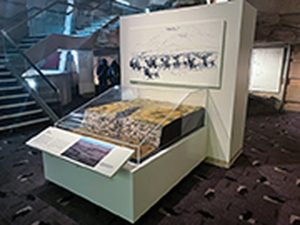New exhibit at Head-Smashed-In showcases ancestral buffalo hunts

New Buffalo Hunt exhibit at Head-Smashed-In Buffalo Jump illustrates traditional hunting methods of the Blackfoot people. Ministry of Arts, Culture and Status of Women
By Somya Lohia, Local Journalism Initiative Reporter
A new exhibit at Head-Smashed-In Buffalo Jump is bringing fresh attention to the ancient tradition of the buffalo hunt, honouring the ingenuity and deep cultural roots of the Blackfoot people while offering visitors a vivid glimpse into a complex, ceremonial and communal practice that sustained their communities for millennia.
Unveiled June 18, the display features a striking diorama of a buffalo hunt, donated by the Canadian Museum of History.
The installation captures the strategy and complexity of the hunt as practised by Blackfoot ancestors for thousands of years on this very site — one of the oldest and best-preserved buffalo jumps in North America.
Now a UNESCO World Heritage Site, Head-Smashed-In Buffalo Jump lies within the traditional territory of the Blackfoot peoples and represents a history that is both ancient and living.
Archeological digs beneath the cliff, beginning in 1948, revealed layers of bones, stone tools and firepits — evidence of repeated, organized hunts dating back more than 6,000 years, said Quinton Crow Shoe (Blackfoot name: Kainaikoan), special events co-ordinator and marketing lead at the interpretive centre.
“Our ancestors were herding up the buffalo and tricking them over the cliff before pyramids of Egypt, before Stonehenge,” Crow Shoe told Shootin’ the Breeze. But the stories remain very much alive, he added.
In 1981, the site was designated a UNESCO World Heritage Site, not only for its archeological importance, but also because Blackfoot culture, stories and traditions remain deeply connected to the land.
That connection helped shape the interpretive centre itself.
“After the designation, there was a notion of maybe having some sort of interpretive centre here to share this amazing story with people from around the world,” Crow Show said.
His grandfather, Joe Crow Shoe Sr., helped gather support from Blackfoot communities across Alberta and Montana and collected traditional knowledge to guide the project.
Respecting the sacred nature of the land was central to the project. To preserve the integrity of the landscape, the centre was designed to blend into the cliff itself, with a very small part of the centre visible from the outside.
The cement was tinted to match the surrounding sandstone — a compromise that allowed for education and preservation to go hand in hand.
“When you drive up, you only see 10 per cent of the building,” said Crow Shoe.
The interpretive centre shares this living history across five levels of exhibits.
“When people come here, they realize that they’re only where the buffalo went over the cliff. It’s a much bigger picture than that,” Crow Shoe said.
He explained the planning and strategy behind the hunt, which drew buffalo from a 15-kilometre gathering basin using ecological cues, drive lanes, and ceremonial guidance tied to the land and stars.
“This particular buffalo jump was a planned hunt, where they would go through the ceremony. They call it the buffalo stone ceremony, and then they would commence planning for the hunt,” he said.
“So this jump, when they say it’s the biggest, the oldest, the most used, best preserved, is because it used all the natural elements.”
The centre’s newest addition — a detailed diorama depicting the buffalo hunt — is a replica of the original display housed at the Canadian Museum of History in Ottawa.
Sharing the origins of the partnership, Crow Shoe said representatives from the museum first contacted him around 2015 or 2016 while planning the museum’s new History Hall, looking to include the story of the buffalo hunt.
Piikani elder Wilfred Yellow Wings became the voice of the story, sharing teachings that were incorporated into the national exhibit. A replica of the diorama has now come to Head-Smashed-In.
“Dave Dean spent over 5,000 hours constructing this diorama, putting it together, building all the little buffaloes and the cliff,” said Crow Shoe. “The Canadian Museum donated that whole diorama to us.”
The entire third level of the centre was reimagined to accommodate the new display, which includes refreshed panels and cases. While discussions began in 2017, Crow Shoe said the pace was intentional.
“We didn’t want to rush things,” he said. “We wanted to make sure that the elders were kept in the loop.”
The exhibit was launched in the presence of Minister of Arts, Culture and Status of Women Tanya Fir, Piikani Nation Chief Troy Bossman Knowlton, Kainai Nation Chief Travis Plaited Hair, Livingstone-Macleod MLA Chelsea Petrovic, and Canadian Museum of History curator Tim Foran, along with elders, knowledge keepers and other dignitaries.
In the two weeks since its opening, feedback has been enthusiastic.
“Lots of online social media, Google reviews, Trip Advisor, lots of great feedback,” said Crow Shoe. “Immediate reaction is exactly what we anticipated. We are so happy with the display and we know that visitors won’t be disappointed.”
Beyond showcasing history, Crow Shoe sees the site and the exhibit as an important tool for reconciliation.
“Reconciliation is ongoing. Everybody has to embrace it, understand it, and this site here does a wonderful job,” he said.
The centre is also inviting visitors to experience the culture in motion — with drumming and dancing performances every Wednesday in July and August at 11 a.m. and 1:30 p.m., free on the plaza.
As Crow Shoe put it, “This site here does a good job in turning minds and sharing our beautiful history. It just goes a long way in promoting unity.”
